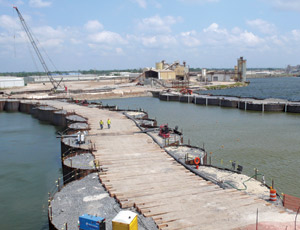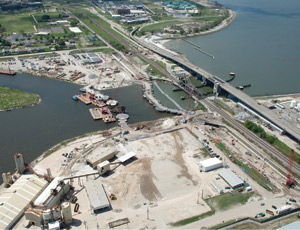If a storm surge threatens New Orleans from Lake Pontchartrain this hurricane season, a hefty, cellular-style cofferdam will reduce the risk of it pushing into the Inner Harbor Navigation Canal and flooding areas of the city.


The interim structure designed by Alberici Constructors, St. Louis, Mo., will allow the contractor to build the permanent Seabrook Floodgate Complex in the dry. Two rows of circular-cell cofferdams now close the canal temporarily. Dry construction means “a higher-quality product as well as increased efficiency and safety,” says Dave Calcaterra, Alberici project manager and vice president.
The $155-million complex is part of the U.S. Army Corps of Engineers' hurricane and storm-surge risk-reduction system to protect New Orleans from floods with a 1% chance of occurring each year—a so-called 100-year event.
The complex will have a 95-ft-wide navigable sector gate, two 50-ft-wide non-navigable, vertical lift gates and 1,600 linear ft of concrete T-walls tied into the canal's floodwalls. The 16-ft-plus-elevation complex will work with the IHNC-Lake Borgne surge barrier and its gates at the other end of the canal.
Alberici came up with the cofferdam design as an alternative to a Corps' plan for a double combi-wall cofferdam, essentially two sheet-pile rows filled with sand and rock around all four sides of the project area, says Eric Stricklin, Corps project manager. “Alberici proposed the circular cell dams, which created a significant time and cost savings,” he says.
The original plan would have required a tremie seal slab. “We have eliminated the need for about 25,000 cu yd of concrete,” says Calcaterra.
Alberici recommended its cofferdam idea while it was preforming preconstruction services during design review at the conceptual stage under an early-contractor-involvement base contract of $495,000, awarded in October 2009. The Corps exercised the construction option to engage Alberici to proceed with the work for $154.5 million last July. “[The ECI process] has been very effective at Seabrook,” Calcaterra says.
Before building the cofferdam, Alberici installed a rock dike across the canal to address an old, 95-ft-deep scour hole just south of the Ted Hickey Bridge, also known as the Seabrook Bridge, which crosses the canal where it meets Lake Pontchartrain. “We needed the rock dike to slow the water flow so they could fill the scour hole to -28 ft,” Stricklin says.
Alberici used sand fill and vibrocompaction to achieve consolidation. “We had to use pretty large vibrations on a grid to get the sand consolidated—1,200 to 1,400 points vibrocompacted, eight feet on center,” Calcaterra says.
Alberici's cofferdam has 11 60-ft-dia and three 40-ft-dia cells joined by arc connectors. Construction began in November and finished in mid-April. The excavation between the dams is about 140 ft wide, stretches more than 360 ft from bank to bank and has a depth of -33 ft.
On April 29, Houston-based Griffin Dewatering Corp. began pumping 15 million gallons of water from the site. It also used 42 10-in.-dia, 75-ft-deep wells outside the dam perimeter to lower the groundwater table and relieve external hydraulic pressure.
Griffin is working on several Corps projects in New Orleans, but Michael Lippard, Griffin senior project manager, says Seabrook is "extraordinary" because of the depth of the wells, the size of the cofferdam, the amount of water moved, and the dewatering of a backfilled, vibrocompacted area. “Normally, when we are dewatering, it's virgin ground,” Lippard says. “The soils in here are more permeable than natural soils.”
A team from the Corps' Engineer Research & Development Center in Vicksburg, Miss., stood by to relocate wildlife stranded by the operation, particularly Gulf sturgeon, an endangered species, Stricklin says.
Once the excavation is dry and ready, the next step will be a six-week, around-the-clock operation to drive foundation piles for the permanent complex. “We're driving 414 74- to 86-ft-long, 32-in.-dia pipe piles through consolidated sand on 7-ft centers,” Calcaterra says.

Post a comment to this article
Report Abusive Comment